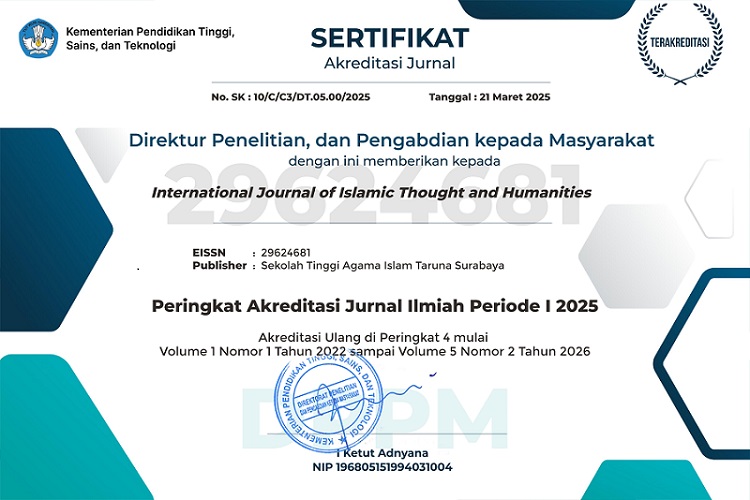Perception of School Citizens about Violence against Students
DOI:
https://doi.org/10.54298/ijith.v2i1.89Keywords:
Perception, Violence, Students, School MembersAbstract
One of the social realities about violence against students at MTS Nurul Khoir Surabaya that attracts attention, namely violence in the form of "stabbing" carried out by fellow students because the perpetrator feels disappointed with the victim who often commits physical violence or verbal violence against perpetrators and other students. This study aims to describe and analyze the perceptions of school members about violence against students at MTS Nurul Khoir Surabaya and the indicators underlying the perceptions of school members about violence against students at MTS Nurul Khoir Surabaya using a qualitative approach. The findings of this study indicate that 1) The perceptions of school members about violence against students at MTS Nurul Khoir Surabaya are different, such as there are informants who give positive assessments, namely violence against students is a natural thing because students are entering their teens who are still looking for identity, as well as violence against students can make students mentally strong. While the negative assessment, namely the existence of informants' disapproval of violence against students at MTS Nurul Khoir Surabaya because it is an action that can injure students physically and mentally and disrupt teaching and learning activities at school, 2) Indicators underlying the perceptions of school residents about violence towards students at MTS Nurul Khoir Surabaya including a) there is the absorption of objects namely violence against students at MTS Nurul Khoir Surabaya, b) there is an understanding or understanding of violence against students at MTS Nurul Khoir Surabaya, and c) there is an assessment or an evaluation of violence against students at MTS Nurul Khoir Surabaya from each school member informant, thus creating different perceptions.
Downloads
References
Agustina, D. (2022). Makna Kekerasan Dalam Perspektif Guru dan Siswa. Pendidikan Sosiologi , 4, 122.
Ani Yuniati, Suyahmo, dan Juhadi. (2017). Perilaku Menyimoang dan Tindak Kekerasan Siswa SMP di Kota Pekalongan. Journal Of Educational Social Studies , 1.
Assegaf, A. R. (2004). Pendidikan Tanpa Kekerasan: Tipologi Kondisi, Kasus dan Konsep. Yogyakarta: Tiara Wacana Yogya.
Barad, A., & Upadhiya, S. (2020). Domestic violence: A psychiatric view point. Indian Journal of Psychiatry, 62(7 Supplement 1).Dadan Sumara, S. H. (2017). Kenakalan Remaja dan Penanganannya. Jurnal Penelitian dan PPM , 347-348.
Bax, T. (2019). Iljin in the Making: The Life Course of Perpetrators of School Violence in South Korea. In Asian Journal of Social Science (Vol. 47, Issue 1). https://doi.org/10.1163/15685314-04701002
Dalbert, D. d. (2007). Student Violence Against Teachers: Teachers' Well-Being and the Belief in a Just World. European Psychologist World , 12, 253-260.
Diyah, Nur Cholifa Maulut. (2016). Kekerasan Dalam Pendidikan (Studi Fenomenologi Perilaku Kekerasan Di Rehabilitas Sosial Anak). Paradigma , 1.
Chacon, M., & Raj, A. (2022). The Association Between Bullying Victimization and Fighting in School Among US High School Students. Journal of Interpersonal Violence, 37(21–22). https://doi.org/10.1177/08862605211055075
Dugarova, E. (2015). Social Inclusion, Poverty Eradication and the 2030 Agenda for Sustainable Development. UNRISD.
Garcia, D. S. (2015). Using Targeted Sanction To End Violations Againts Children In Armed Conflict. Boston University International Law Journal , 15.
Hafidzi, R. R. (2018). Studi Tentang Perilaku Menyimpang Pada Siswa di MI Nuruddin I Banjarmasin. Jurnal Ecopsy , 100.
Hammaren, N. (2022). Are Bullying and Reproduction of Educational Inequality The Same Thing? Towards a Multifaceted Understanding of School Violence. Power and Education , 0, 1-15.
Hanandini, W. P. (2022). Tindak Kekerasan Terhadap Anak di Sekolah: Bentuk dan Aktor Pelaku. Administrasi Publik dan Pemerintahan , 1, 9-11.
Hurlock, E. B. (1990). Psikologi Perkembangan (Suatu Pendekatan Sepanjang Rentang Kehidupan). Jakarta: Erlangga.
Kotok, S., & Sorden, A. (2022). School Choice, Competition, and Disruptions for a High-Achieving Traditional Public School. Journal of Cases in Educational Leadership, 25(2). https://doi.org/10.1177/15554589221078275
Kriminolog: Pengantar Sebab-Sebab Kejahatan1987BandungPolitea
Krisbiantoro, J. (2008). Kekerasan terhadap Anak dalam Perspektif Pendidikan. Jurnal Forum Ilmu Sosial , 15.
Kurniawan, Hanifah Titi Ananingsih dan Muhammad Ragil. (2018). Persepsi Guru, Kepala Sekolah, dan Wali Murid Tentang Fenomena Kekerasan di Dunia Maya Terhadap Anak. Fundamental Pendidikan Dasar , 183.
Larhant, C., Raymond, S., & Gasman, I. (2020). Aviolicide: A substitute parricide? A case report. Annales Medico-Psychologiques, 178(4). https://doi.org/10.1016/j.amp.2019.02.007
Lee, J. J., Kim, J. H., & Kim, B. N. (2021). Effects of school bullying prevention camp on the adolescent perpetrators of school violence. Journal of the Korean Academy of Child and Adolescent Psychiatry, 32(2). https://doi.org/10.5765/jkacap.200043
McLaughlin, D., Keir, M., Foster, H., & Jandial, S. (2022). Chronic arthritis in children and young people. In Medicine (United Kingdom) (Vol. 50, Issue 3). https://doi.org/10.1016/j.mpmed.2021.12.004
Muhammad, D. H., & Desari, A. E. (2023). Early Child Education Based on Islamic Psychology. International Journal of Islamic Thought and Humanities, 2(1 SE-Articles), 12–20. https://doi.org/10.54298/ijith.v2i1.51
Moleong, L. J. (2002). Metode Penelitian Kualitatif. Bandung: PT Remaja Rosda Karya.
Nurani, S. (2010). Teori-Teori Pendidikan "Tradisional Neoliberal, Marxis Sosialis, Postmodern". Yogyakarta: Ar Ruz Media Group.
Nurani, S. (2010). Teori-Teori Pendidikan "Tradisional Neoliberal, Marxis Sosialis, Postmodern". Yogyakarta: Ar Ruz Media Group.
Nurmaliyah, Y., Aripin, S., & Nurdiansyah, N. M. (2023). 2013 Curriculum: Implementation of Islamic Religious Education Learning in Schools for Children with Special Needs. International Journal of Islamic Thought and Humanities, 2(1 SE-Articles), 124–138. https://doi.org/10.54298/ijith.v2i1.83
Organization, W. H. (2020). Global Status Report On Preventing Violence Againts Children 2020. United Nations: UNICEF, WHO.
Pencegahan Kekerasan terhadap Anak di Lingkungan Pendidikan2007JakartaP2TP2A
Psikologi Umum1993YogyakartaAndi Offset
Robbins, S. P. (2007). Perilaku Organisasi Buku I. Jakarta: Salemba Empat.
Suda, I. (2019). Domestikasi Kekerasan Simbolik di Sekolah: Perspektif Sosiologi Pendidikan. Widyacarya , 6, 22-29.
Sujono, I., Malaka, Z., Istifhama, L., Nasiri, N., & Anah, S. (2022). Efforts to Strengthen Islamic Moderation of Islamic Religious Universities in Indonesia. Proceedings of the 6th Batusangkar International Conference, BIC 2021, 11 - 12 October, 2021, Batusangkar-West Sumatra, Indonesia. https://doi.org/10.4108/eai.11-10-2021.2319459
Susanto, R., Rozali, Y. A., & Agustina, N. (2019). Development of pedagogical competency models for elementary school teachers: Pedagogical knowledge, reflective ability, emotional intelligence and instructional communication pattern. Universal Journal of Educational Research, 7(10). https://doi.org/10.13189/ujer.2019.071010
Syafei, M. S. (2006). Bagaimana Anda Mendidik Anak . Bogor: Ghalia Indonesia.
Syukur, A., Nata, A., Rosyada, D., & Suralaga, F. (2023). Learning Management of Islamic Religious Education (PAI) Based on Multiple Intelligences at SMA IT Insan Mandiri Cibubur. International Journal of Islamic Thought and Humanities, 2(1 SE-Articles), 21–39. https://doi.org/10.54298/ijith.v2i1.52
Walgito, B. (2010). Pengantar Psikologi Umum. Yogyakarta: CV Andi Offset.
Windha Ayu Safitri, D. S. (2013). Dampak Kekerasan dalam Berpacaran (The Impact of Violence in Dating). Kesejahteraan Sosial , 1, 4.
Wilson, A. N., Dzugan, E., & Hutchinson, V. D. (2022). Correction to: Using a Nonconcurrent Multiple-Baseline Across-Participants Design to Examine the Effects of Individualized ACT at School. Behavior Analysis in Practice, 15(1). https://doi.org/10.1007/s40617-021-00623-2
Downloads
Published
How to Cite
Issue
Section
License
Copyright (c) 2023 Zuman Malaka, Bambang Satriya, Kridawati Sadhana

This work is licensed under a Creative Commons Attribution-ShareAlike 4.0 International License.
Authors who publish with this journal agree to the following terms:
- Authors retain copyright and grant the journal right of first publication with the work simultaneously licensed under a Creative Commons Attribution-ShareAlike 4.0 that allows others to share the work with an acknowledgement of the work's authorship and initial publication in this journal.
- Authors are able to enter into separate, additional contractual arrangements for the non-exclusive distribution of the journal's published version of the work (e.g., post it to an institutional repository or publish it in a book), with an acknowledgement of its initial publication in this journal.
- Authors are permitted and encouraged to post their work online (e.g., in institutional repositories or on their website) prior to and during the submission process, as it can lead to productive exchanges, as well as earlier and greater citation of published work (See The Effect of Open Access).


















